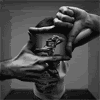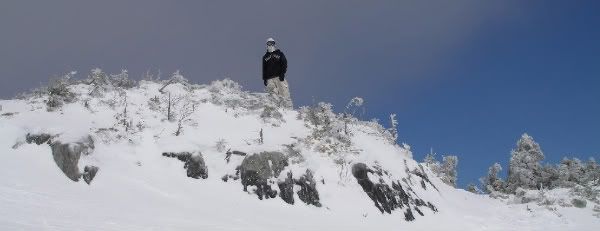I started doing some research today into the various materials that goes into a skiboard and found a wealth of information. What started this was comparing the Summit Maurader 125 vs the Lacroix Carbon 125, with the Maurader using p-tex 4000 vs. Lacroix using p-tex 2000. Therefore, I think it could be helpful to start some threads about the materials used.
First up, what is Titanal? (besides two obscene words put together):
The use of metal is nothing new. In fact, metals have been used in ski construction for more than forty years. There is one metal in particular that seems to be mentioned most and considered to be the best. That metal is known as Titanal. What is this metal exactly and how does it affect the performance? This article will attempt to shed some light on this amazing material and how its properties are suited for snowboard construction.
"Old Titanal" dates back to the 60s: It was sold under the Aluflex brand, and it was actually an aluminum sheet.
Titanal is produced by an Austrian company known as AMAG Rolling. This company has a sports division with a long history of providing high strength aluminum alloys for recreational manufacturing. AMAG Rolling describes Titanal as follows “Titanal is a high strength, age hardenable aluminum-wrought-alloy”. Contrary to what many people may believe, Titanal is not titanium and in fact does not contain any titanium. The chemical composition of Titanal® in weight percent breaks down to approximately 88.5% aluminum, 1.7% copper, 2.5% magnesium, 7% zinc, and 0.1% zirconium. Knowing the chemical composition allows for a comparison of this alloy to other familiar aluminum alloys.
The chemical composition of Titanal lists the major alloying element as zinc at approximately 7%. This would mean that it would be similar to aluminum alloys in the 7xxx series. This indicates a material comparable to that used in the aerospace industry where high strength and low weight are of paramount importance.
Aluminum, like steel, is a ductile material. This means that the initial portion of the stress vs. strain curve is a straight line with a steep slope. The peak of this line is a point known as the yield point. The stress at this point is known as the yield stress (sy). After the yield point, the material undergoes further deformation up to the ultimate stress (su) and continues on to the stress at which failure or rupture occurs (sB), also known as the breaking strength. A brittle material like glass, does not have a yield point, the ultimate stress equals the breaking strength.
It can be seen that a ductile material like aluminum can be highly stressed up to the yield point without permanent deformation since the material will spring back to its normal state after being loaded. A comparison of the yield stress of structural steel, 7075-T6 aluminum and Titanal.
Material Yield Stress (MPa)
Structural Steel (ASTM-A36) 250
Aluminum Alloy 7075-T6 500
Titanal 580
As can be seen, aluminum alloys are very strong. This high strength coupled with low weight and ductility combine to make for an excellent material for skiboard construction.
A typical skiboard consists of a wood core sandwiched between layers of fiberglass. The fiberglass layers are typically a bi-axial or tri-axial glass (snowboards also use quad-axial glass). Once the epoxy has cured these glass layers form a composite matrix with the wood core. The reason that most manufacturers use bi-axial, tri-axial or quad-axial glass is to increase the torsional rigidity of the board. The more directions the glass fibers run, the better the composite is at resisting loads in those directions. This is where Titanal makes such a difference. The use of a very thin layer of aluminum takes the place of the fiberglass. The tensile loads are resisted by the aluminum and the aluminum responds in all directions. The pathways for the load to be resisted are no longer limited to the directions of the glass fibers.
Titanal provides more torsional stiffness, and gives a damper response. As a result, it is much easier to carve on icy slopes than with a regular skiboard - there is really no comparison. At first glance, a Titanal-enhanced skiboard would seem likely to help only folks who are already at the top of their game on the race course. However, carvers are reporting that Titanal improves the performance of any type of board (all-mountain, freecarve, race) for freecarving as well as racing, and for people with various degrees of carving skill. Presumably, if Titanal can smooth out the bumpiness from badly groomed ice, then it could theoretically benefit anyone.
Why are there not more skiboards with aluminum inside? The answer is two fold. One, fiberglass is cheaper. Two, aluminum can be difficult to bond if not done correctly. One of the properties of aluminum that makes it easy on the eyes also makes it difficult to bond. Aluminum reacts with the atmosphere and oxidizes a very thin layer over its surface. This layer acts a protective coating and is the reason why many aluminum structures are not painted. This thin protective coating can make bonding with epoxy difficult. The epoxy will bond to the thin layer and then peel right off once cured. There are some physical and chemical processes employed to prevent this from happening.
First up, what is Titanal? (besides two obscene words put together):
The use of metal is nothing new. In fact, metals have been used in ski construction for more than forty years. There is one metal in particular that seems to be mentioned most and considered to be the best. That metal is known as Titanal. What is this metal exactly and how does it affect the performance? This article will attempt to shed some light on this amazing material and how its properties are suited for snowboard construction.
"Old Titanal" dates back to the 60s: It was sold under the Aluflex brand, and it was actually an aluminum sheet.
Titanal is produced by an Austrian company known as AMAG Rolling. This company has a sports division with a long history of providing high strength aluminum alloys for recreational manufacturing. AMAG Rolling describes Titanal as follows “Titanal is a high strength, age hardenable aluminum-wrought-alloy”. Contrary to what many people may believe, Titanal is not titanium and in fact does not contain any titanium. The chemical composition of Titanal® in weight percent breaks down to approximately 88.5% aluminum, 1.7% copper, 2.5% magnesium, 7% zinc, and 0.1% zirconium. Knowing the chemical composition allows for a comparison of this alloy to other familiar aluminum alloys.
The chemical composition of Titanal lists the major alloying element as zinc at approximately 7%. This would mean that it would be similar to aluminum alloys in the 7xxx series. This indicates a material comparable to that used in the aerospace industry where high strength and low weight are of paramount importance.
Aluminum, like steel, is a ductile material. This means that the initial portion of the stress vs. strain curve is a straight line with a steep slope. The peak of this line is a point known as the yield point. The stress at this point is known as the yield stress (sy). After the yield point, the material undergoes further deformation up to the ultimate stress (su) and continues on to the stress at which failure or rupture occurs (sB), also known as the breaking strength. A brittle material like glass, does not have a yield point, the ultimate stress equals the breaking strength.
It can be seen that a ductile material like aluminum can be highly stressed up to the yield point without permanent deformation since the material will spring back to its normal state after being loaded. A comparison of the yield stress of structural steel, 7075-T6 aluminum and Titanal.
Material Yield Stress (MPa)
Structural Steel (ASTM-A36) 250
Aluminum Alloy 7075-T6 500
Titanal 580
As can be seen, aluminum alloys are very strong. This high strength coupled with low weight and ductility combine to make for an excellent material for skiboard construction.
A typical skiboard consists of a wood core sandwiched between layers of fiberglass. The fiberglass layers are typically a bi-axial or tri-axial glass (snowboards also use quad-axial glass). Once the epoxy has cured these glass layers form a composite matrix with the wood core. The reason that most manufacturers use bi-axial, tri-axial or quad-axial glass is to increase the torsional rigidity of the board. The more directions the glass fibers run, the better the composite is at resisting loads in those directions. This is where Titanal makes such a difference. The use of a very thin layer of aluminum takes the place of the fiberglass. The tensile loads are resisted by the aluminum and the aluminum responds in all directions. The pathways for the load to be resisted are no longer limited to the directions of the glass fibers.
Titanal provides more torsional stiffness, and gives a damper response. As a result, it is much easier to carve on icy slopes than with a regular skiboard - there is really no comparison. At first glance, a Titanal-enhanced skiboard would seem likely to help only folks who are already at the top of their game on the race course. However, carvers are reporting that Titanal improves the performance of any type of board (all-mountain, freecarve, race) for freecarving as well as racing, and for people with various degrees of carving skill. Presumably, if Titanal can smooth out the bumpiness from badly groomed ice, then it could theoretically benefit anyone.
Why are there not more skiboards with aluminum inside? The answer is two fold. One, fiberglass is cheaper. Two, aluminum can be difficult to bond if not done correctly. One of the properties of aluminum that makes it easy on the eyes also makes it difficult to bond. Aluminum reacts with the atmosphere and oxidizes a very thin layer over its surface. This layer acts a protective coating and is the reason why many aluminum structures are not painted. This thin protective coating can make bonding with epoxy difficult. The epoxy will bond to the thin layer and then peel right off once cured. There are some physical and chemical processes employed to prevent this from happening.





Comment